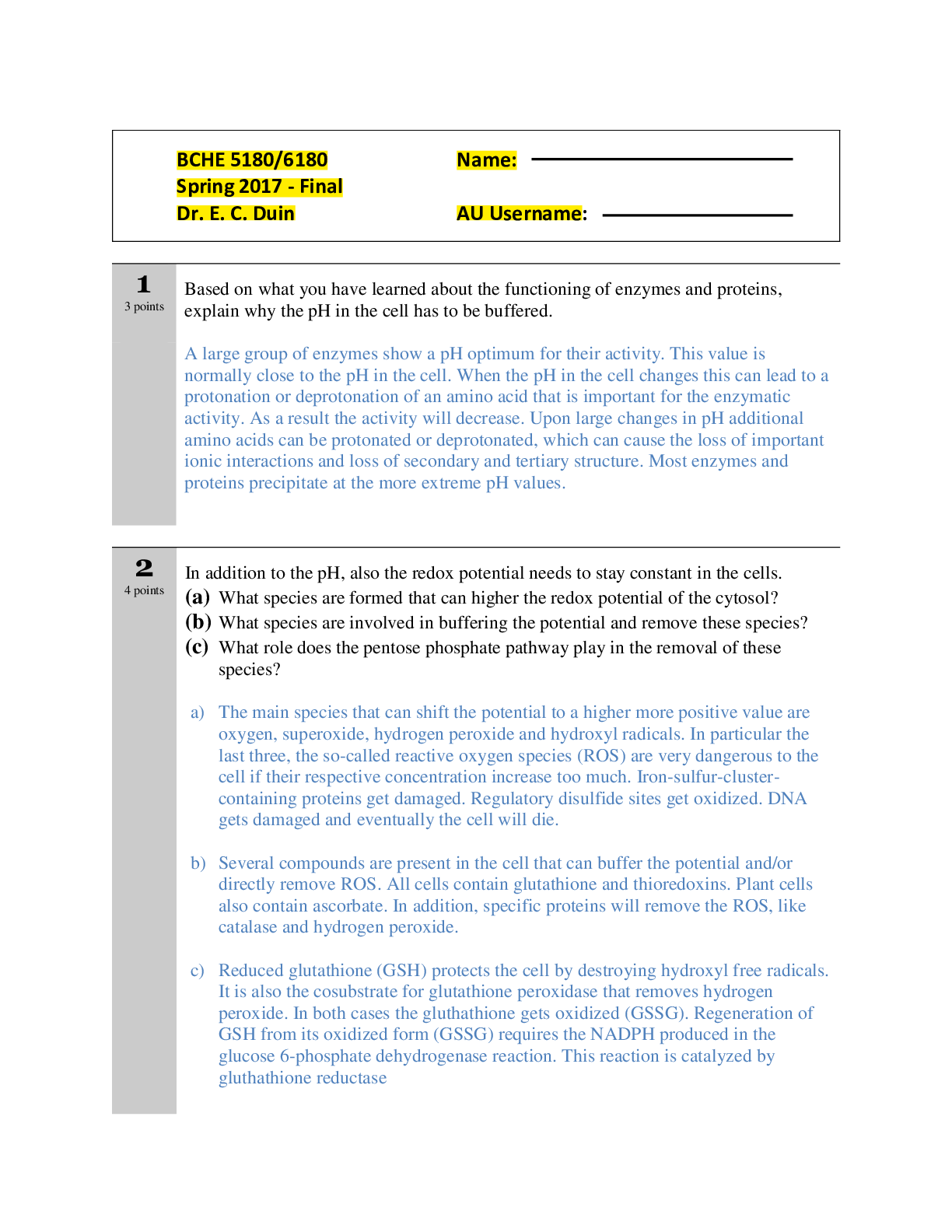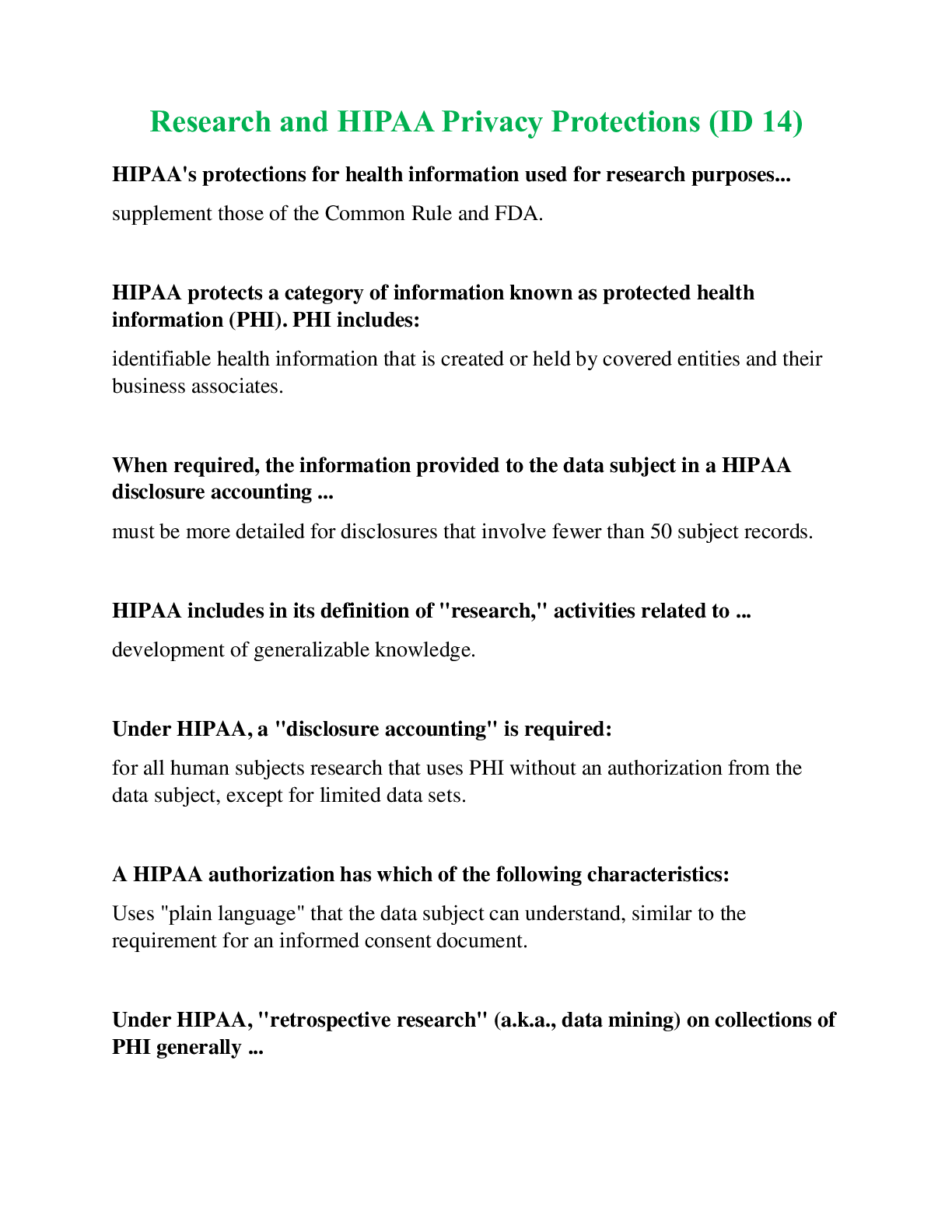Chemistry > QUESTIONS & ANSWERS > BCHE 5180/6180: Spring Final. All Answers Provided (All)
BCHE 5180/6180: Spring Final. All Answers Provided
Document Content and Description Below
1. Based on what you have learned about the functioning of enzymes and proteins explain why the pH in the cell has to be buffered. 2. In addition to the pH, also the redox potential needs to stay con... stant in the cells. (a) What species are formed that can higher the redox potential of the cytosol? (b) What species are involved in buffering the potential and remove these species? (c) What role does the pentose phosphate pathway play in the removal of these species? 3. For a peptide with the sequence shown below determine the pI. Glu–His–Trp–Ser–Gly–Leu–Arg–Pro–Gly (Hint: If you cannot do that directly, first calculate the charge at different pH values and use those to find the pI region.). 4. The cyanobacterium Nostoc punctiforme can live in symbiosis with plants. The signal peptide nostopeptolide A1 plays an important role in the symbiosis. Some of the amino acids have been modified, like the methyl-proline (mPro), the acetylated Leucine (LeuAc) and there is also a butyrate group attached. Can you assign the remaining amino acids (circled with a solid line). 5. Explain the principle of hydrophobic interaction chromatography. For each of these purifications provide a detailed explanation whether you think the protein is pure or not and whether additional steps are needed to confirm purity. Note that the total activity is indicated, not the specific activity. 6. For each of these purifications provide a detailed explanation whether you think the protein is pure or not and whether additional steps are needed to confirm purity. Note that the total activity is indicated, not the specific activity. 7. In question 6, only the total activity was indicated and not the specific activity. (a) Explain how these are different. (b) Would your answers have been different if the specific activity would have been given for each step? 8. Describe/draw in detail the ‘catalytic cycle’ of the folding of proteins by the GroEL/GroES complex. Explain in detail the different steps. (b) Why does this process require ATP? A folded protein has a much lower potential energy than the unfolded proteins and therefore the folding process should in principle produce energy not require energy. 9. What is the effect of O2, H+, CO2, and 2,3-bisphosphoglycerol (BPG) on Hemoglobin 10. Explain how the effects of sickle cell disease demonstrate that hemoglobin undergoes a conformational change upon releasing oxygen. 11. Write out the Michaelis-Menten equation and the reaction equation that describes the mechanism for enzyme action used as a model by Michaelis and Menten. Under what assumptions and conditions can we use this equation? (List all 5). 12. Describe in details the difference between competitive, noncompetitive and uncompetitive inhibitors. (b) Give a shortly description on how the identity of an unknown inhibitor can be established through simple activity measurements. 13. What does a large KI value for a competitive inhibitor indicate about the potency of the inhibition? Note that the equation that relates KI to values from the graphs is shown below. 14. Describe the basic differences between second order reaction types: Sequential/single displacement reactions vs. double-displacement (ping-pong) reactions. 15. Describe in detail how the sugar code is used to direct white blood cells to sites of inflammation 16. List and explain the five reasons why the hydrolysis of ATP has a large negative ΔG°’ value. 17. Draw the glycolysis pathway from glucose to glyceraldehyd-3-phosphate (include all the structures of the intermediates in the pathway, the names of these compounds, other small molecules, and the names of the enzymes catalyzing the respective reactions). 18. The cofactor thiamine pyrophosphate (TPP) is used by pyruvate decarboxylase (a) Draw the complete structure of this cofactor (b) Draw part of the mechanism to explain the important role of this cofactor in the reaction mechanism. Provide an explanation with the drawing. 19. (a) In class we learned that typical metabolic pathways contain some reactions that are close to equilibrium and a few reactions that are for from equilibrium. This has important consequences for how the flux of metabolites through a pathway is regulated. Explain why that is. (b) Explain how this method of regulation translates into the specific way glycolysis and gluconeogenesis are regulated 20. There are three forms (isozymes) of glycogen phosphorylase: brain (bGP), liver (lGP) and muscle (mGP). (a) What is the function of this enzyme and how is the activity of mGP and lGP regulated? Indicate the effect of the different types of regulatory compounds on the activity of GP by drawing additional curve in the plot below. (b) Brain glycogen phosphorylase is also regulated by H2O2. Explain what how that works and what the positive and possible negative effects are of this type of regulation. [Show More]
Last updated: 1 year ago
Preview 1 out of 15 pages

Buy this document to get the full access instantly
Instant Download Access after purchase
Add to cartInstant download
We Accept:

Reviews( 0 )
$13.00
Document information
Connected school, study & course
About the document
Uploaded On
Mar 15, 2020
Number of pages
15
Written in
Additional information
This document has been written for:
Uploaded
Mar 15, 2020
Downloads
0
Views
41














